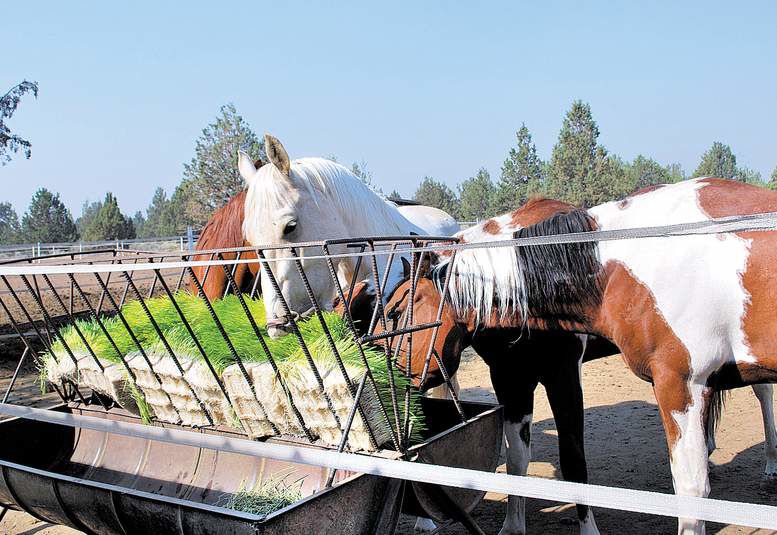Bend man grows feed in new way
Published 5:00 am Monday, October 3, 2011

- Horses eat sprouted grain livestock feed grown in refrigerator-sized Fodder Feeds units at the Straights’ ranch near Bend. The units are designed for smaller ranches or hobby farms with 10 to 12 horses or steers.
David Straight spent most of his life running ranches and building houses in California and Southern Oregon before he moved to Bend just in time for the housing market crash.
But instead of lamenting tough times, Straight changed course and started Fodder Feeds in July 2010, and built what he described as a kind of high-tech pasture on wheels, producing livestock feed with a fraction of the water and land and none of the pesticide used in traditional methods.
Trending
Inside one of the company’s climate-controlled 8-by-25-foot trailers, Straight says, a rancher can hydroponically grow more sprouted grains to use as animal feed in six days than a 40-acre field of alfalfa hay produces in a month.
“We take nature’s normal 30-day process for growing a seed to an 8-inch sprout, and we do it in six days,” Straight said. “We turn two pounds of seed into 18 to 20 pounds of highly nutritious feed in six days.”
Agricultural and feed industry experts in Central Oregon said they’ve seen an increased interest recently in feeding sprouted grains, the point where a planted seed straddles the line between seed and new plant, as alternative to hay.
Mylen Bohle, crop and forage specialist with the Oregon State University Extension Service in Central Oregon, said he partially agrees with a Massachusetts Department of Agriculture study that said growing sprouted grain as a feed crop would allow farmers to extend the grazing season. It would also allow them to be more self-sufficient, potentially resulting in less off-farm expenditures and greater monetary returns.
“Does it work, does it do what they say it will? Yes, it does. It turns seed into a sprouted forage,” Bohle said.
However, Bohle said, the potential for farmers and ranchers to reduce feed costs or improve profitability depends, in part, on the cost of the equipment.
Trending
Several other companies in the U.S. and Australia sell systems to hydroponically grow livestock feed from sprouted grains. But Straight said it’s the climate-controlled growing environment in his trailers that makes the difference.
It allows the rapid production of grassy feed about 8 inches tall from a blend of seeds, primarily barley, oat, legume and lentil seeds, Straight said.
“One unit produces 1,000 pounds of feed per day, or over 185 tons a year, which is enough to feed about 56 horses or steers every day for a year,” he said.
“To produce an equivalent amount of feed in a pasture, you’d need 40 acres of good quality irrigated hay ground like you have up in Madras.”
Britt Spaulding, general manager of Round Butte Seed Inc. in Culver, said the sale of barley to ranchers for growing sprouted grain livestock feed started picking up about three or four weeks ago in Central Oregon.
“I can tell you sprouted grain is a type of animal feed. It is relatively new here, but we are getting some calls, and we have sold some barley to people who are growing sprouted grains for livestock feed,” Spaulding said.
Before starting Fodder Feeds last July with a group of investors, Straight said he owned several businesses in the Bend area, including Straight Enterprises, High Mountain Properties and ICF Supply and Building.
He said the potential for growing sprouted grains as a green, alternative livestock feed is “huge.”
“Animal feed is a $200 billion a year industry in the United States right now. We are just a tiny grain in the feed industry,” Straight said Friday en route to delivering two Fodder Feeds units to ranchers in Arizona and Texas.
“If we got 1 percent of the market, that is $2 billion a year in sales.”
Prices for his units range from $7,995 for refrigerator-sized model designed for hobby farms or ranches to $56,000 for an 8-by-25-foot trailer. An 8-by-53-foot Fodder Feeds semitrailer runs $100,000 or more, Straight said.
The feed is grown hydroponically, he said, similar to hydroponic tomato production in greenhouses, and nearly all of the water is recycled except what is actually consumed by the plants.
To grow 20 pounds of feed on farmland with pivot irrigation takes about 400 gallons of water per day. With flood irrigation, it takes about 2,000 gallons of water per day, Straight said.
“With our machine, it takes about 2 gallons of water to produce the same amount of feed. That is a huge water savings,” he said.
Bohle said OSU Extension Service research found that every 10 pounds of barley seed planted and grown hydroponically produced 6 to 7 pounds of sprouted grain feed with a composition of 85 to 90 percent water and 10 to 15 percent dry matter. Ranchers might want to consider that when assessing whether to feed barley in its grain form versus converting it to sprouted grain.
High prices for hay, feed corn, barley, wheat and other feed crops have sparked more interest locally in alternative feeds such as sprouted grain, Bohle said.
Hay prices hit near records in the summer, due partly to high fuel, fertilizer and pesticide costs, and partly to a nationwide hay shortage, Bohle said.
“Last year alfalfa was around $180 per ton. This year it is anywhere from $250 to $300,” Bohle said. “Futures prices are way up,” he said, due to concern about a shortage of hay to feed cattle and other livestock through the winter and into the spring of 2012.
Growing livestock feed in climate-controlled trailers or buildings is a new twist on a decades-old alternative feed crop traditionally grown in farm fields, Straight said. In researching the topic, he said he found articles dating back more than 100 years about feeding animals sprouted grains, but he said it took five years of drought during the past two decades in Australia for the idea of growing the feed in trailers or in feed factory buildings to catch on.
“It has spread to Europe, Saudi Arabia, Northern Africa, South America and Canada,” Straight said. “With the drought going on in the Southwest, we are getting 30 to 40 calls a day from ranchers in Texas, Colorado, New Mexico and Arizona.”
He’s seeking investors, he said, to finance additional manufacturing plants that would turn out more Fodder Feeds growing units.
Bohle said he remembers when a guy built a factory for growing sprouted grains in Montana in the 1960s, but it went out of business after about a year.
“I find it fascinating that here we are 50 years later, and the concept is coming back,” Bohle said.
Fodder Feeds
Founder: David Straight
Employees: Nine
Address: 61037 Groff Road, Bend
Phone: 541-325-3377
Website: www .fodderfeeds.com








